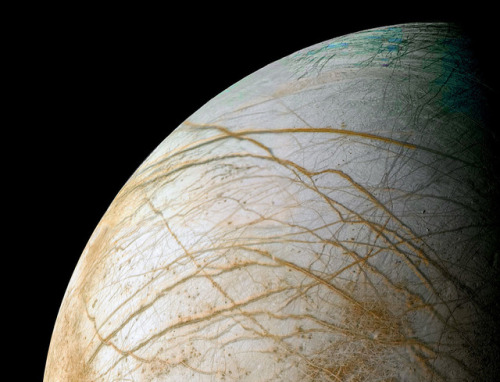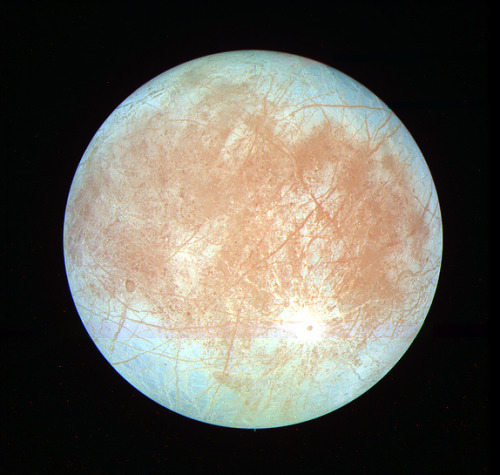A Slow-motion Animation Of The Crab Pulsar Taken At 800 Nm Wavelength (near-infrared) Using A Lucky Imaging

A slow-motion animation of the Crab Pulsar taken at 800 nm wavelength (near-infrared) using a Lucky Imaging camera from Cambridge University, showing the bright pulse and fainter interpulse.
Credit: Cambridge University Lucky Imaging Group
More Posts from Xyhor-astronomy and Others

Should there be a holiday called Astronomy Day?
Where lights are to be turned off for the entire night so everyone could see the stars?








TODAY IN HISTORY: Behold these beautiful shots of the Earth taken from the Gemini 5 spacecraft on August 25, 1965.
(NASA/ASU)

Image of Titan taken by the Cassini spacecraft
NASA/JPL-Caltech/SSI/Kevin M. Gill
The Xpand Your Horizons Family just got bigger! Check out the new pages!
Xpand Your Horizons w/ Paleontology: https://m.youtube.com/playlist?list=PLHFUouhBXdXF6kf0dbsVRghNyDzscVcKc
xyhor-paleontology: https://xyhor-paleontology.tumblr.com
Xpand Your Horizons w/ Archaeology: https://m.youtube.com/playlist?list=PLHFUouhBXdXF6kf0dbsVRghNyDzscVcKc
xyhor-archaeology: https://xyhor-archaeology.tumblr.com
Don’t forget to check out the rest of the family too: https://xpandyourhorizons.tumblr.com/xyhor-family









Europa
Jupiter’s moon Europa is slightly smaller than Earth’s moon. Its surface is smooth and bright, consisting of water ice crisscrossed by long, linear fractures. Like our planet, Europa is thought to have an iron core, a rocky mantle and an ocean of salty water beneath its ice crust. Unlike Earth, however, this ocean would be deep enough to extend from the moon’s surface to the top of its rocky mantle. Being far from the sun, the ocean’s surface would be globally frozen over. While evidence for this internal ocean is quite strong, its presence awaits confirmation by a future mission.
Europa orbits Jupiter every 3.5 days and is locked by gravity to Jupiter such that the same hemisphere of the moon always faces the planet. Because Europa’s orbit is slightly stretched out from circular, or elliptical, its distance from Jupiter varies, creating tides that stretch and relax its surface. The tides occur because Jupiter’s gravity is just slightly stronger on the near side of the moon than on the far side, and the magnitude of this difference changes as Europa orbits. Flexing from the tides supplies energy to the moon’s icy shell, creating the linear fractures across its surface. If Europa’s ocean exists, the tides might also create volcanic or hydrothermal activity on the seafloor, supplying nutrients that could make the ocean suitable for living things.

Europa Clipper
NASA’s planned Europa Clipper would conduct detailed reconnaissance of Jupiter’s moon Europa and investigate whether the icy moon could harbor conditions suitable for life.
The mission would place a spacecraft in orbit around Jupiter in order to perform a detailed investigation of the giant planet’s moon Europa – a world that shows strong evidence for an ocean of liquid water beneath its icy crust and which could host conditions favorable for life. The mission would send a highly capable, radiation-tolerant spacecraft into a long, looping orbit around Jupiter to perform repeated close flybys of Europa. NASA has selected nine science instruments for a future mission to Europa. The selected payload includes cameras and spectrometers to produce high-resolution images of Europa’s surface and determine its composition. An ice penetrating radar would determine the thickness of the moon’s icy shell and search for subsurface lakes similar to those beneath Antarctica’s ice sheet. The mission would also carry a magnetometer to measure the strength and direction of the moon’s magnetic field, which would allow scientists to determine the depth and salinity of its ocean.
Image credit: NASA / JPL / Galileo / Voyager & Processed by Kevin M. Gill
Credit: NASA & Europa Clipper Mission



Solar ❤
How to Discover a Planet: A short step-by-step guide on how each of our planetary neighbors were originally discovered.

Enceladus, moon of Saturn, observed by the Voyager 2 space probe on August 26, 1981, from a distance of approximately 109,000 kilometers.
(Planetary Society)
-
 thisworldisntrealhoney liked this · 1 year ago
thisworldisntrealhoney liked this · 1 year ago -
 demichrising liked this · 1 year ago
demichrising liked this · 1 year ago -
 ravexandxlust liked this · 1 year ago
ravexandxlust liked this · 1 year ago -
 sparkyairstuff liked this · 3 years ago
sparkyairstuff liked this · 3 years ago -
 uglyasfstudyblr reblogged this · 3 years ago
uglyasfstudyblr reblogged this · 3 years ago -
 chopinguy liked this · 3 years ago
chopinguy liked this · 3 years ago -
 leitharstjarna liked this · 3 years ago
leitharstjarna liked this · 3 years ago -
 undertheladdder liked this · 3 years ago
undertheladdder liked this · 3 years ago -
 hath-thee-in-thrall reblogged this · 3 years ago
hath-thee-in-thrall reblogged this · 3 years ago -
 johnbitchsociety reblogged this · 3 years ago
johnbitchsociety reblogged this · 3 years ago -
 johnbitchsociety liked this · 3 years ago
johnbitchsociety liked this · 3 years ago -
 jescache reblogged this · 3 years ago
jescache reblogged this · 3 years ago -
 jescache liked this · 3 years ago
jescache liked this · 3 years ago -
 jonbinary-archive reblogged this · 3 years ago
jonbinary-archive reblogged this · 3 years ago -
 nealmcclure liked this · 4 years ago
nealmcclure liked this · 4 years ago -
 ti-star liked this · 5 years ago
ti-star liked this · 5 years ago -
 astrobio-logy liked this · 5 years ago
astrobio-logy liked this · 5 years ago -
 gulusgammapussy liked this · 5 years ago
gulusgammapussy liked this · 5 years ago -
 pinkclamllamafish liked this · 5 years ago
pinkclamllamafish liked this · 5 years ago -
 nobodylistenstolucy liked this · 5 years ago
nobodylistenstolucy liked this · 5 years ago -
 gia-is-a-punk-rocker liked this · 5 years ago
gia-is-a-punk-rocker liked this · 5 years ago -
 metalzoic liked this · 5 years ago
metalzoic liked this · 5 years ago -
 gingerfan24 liked this · 5 years ago
gingerfan24 liked this · 5 years ago -
 notisaidthechicken liked this · 5 years ago
notisaidthechicken liked this · 5 years ago -
 fagdykefrank liked this · 5 years ago
fagdykefrank liked this · 5 years ago -
 ted-blogs-blog liked this · 5 years ago
ted-blogs-blog liked this · 5 years ago -
 oldfayth liked this · 5 years ago
oldfayth liked this · 5 years ago -
 krdiboy-blog-blog liked this · 5 years ago
krdiboy-blog-blog liked this · 5 years ago -
 caughtin-flux liked this · 5 years ago
caughtin-flux liked this · 5 years ago -
 queen-of-alagaesia liked this · 5 years ago
queen-of-alagaesia liked this · 5 years ago -
 thepizzalovingnerd liked this · 5 years ago
thepizzalovingnerd liked this · 5 years ago
For more content, Click Here and experience this XYHor in its entirety!Space...the Final Frontier. Let's boldly go where few have gone before with XYHor: Space: Astronomy & Spacefaring: the collection of the latest finds and science behind exploring our solar system, how we'll get there and what we need to be prepared for!
128 posts